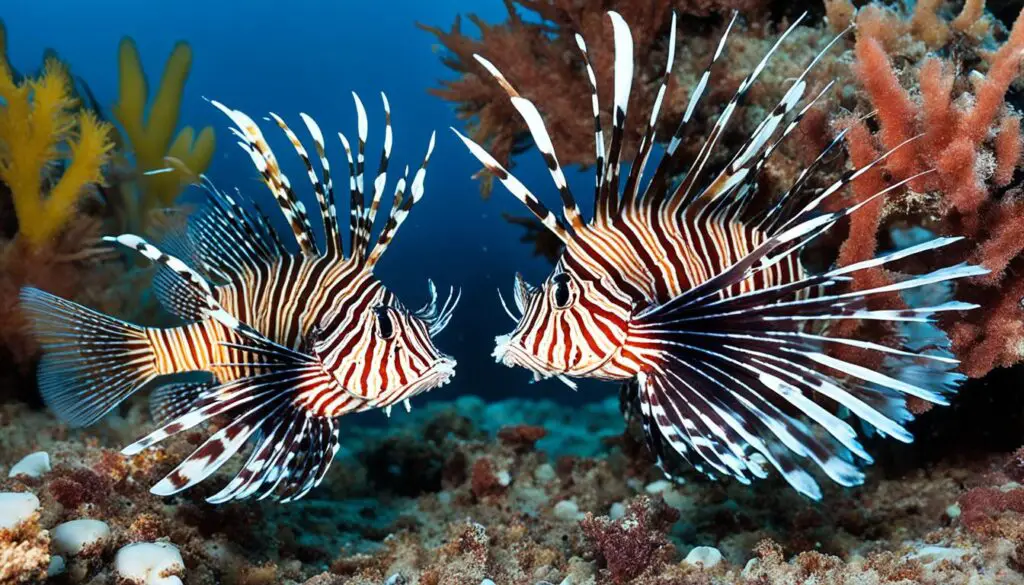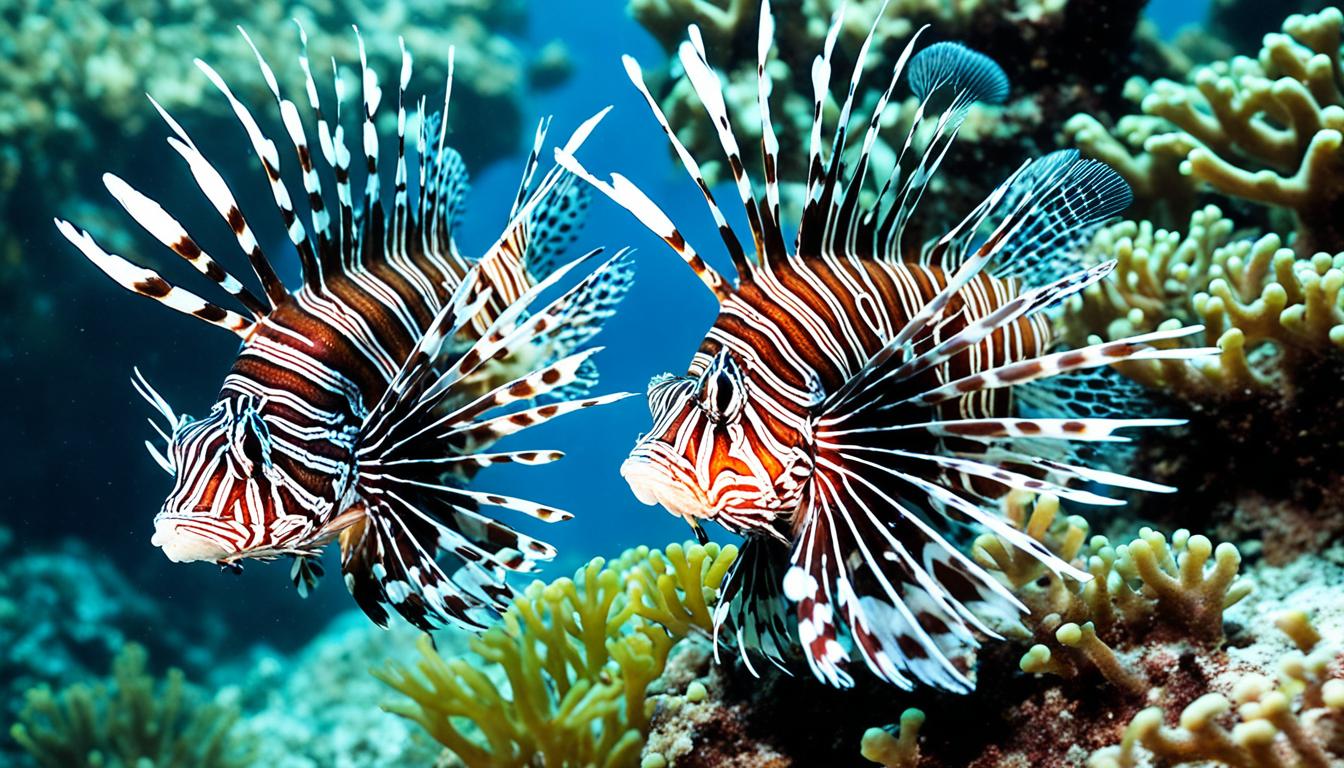Lionfish, like Pterois volitans and Pterois miles, are known for their beauty and their role as invasive predators in the Western Atlantic. They have adapted well to their new home, causing big changes in the ecosystem. A mature female can release up to 2 million eggs a year, making their reproduction fast and effective.
This article will explore how lionfish reproduce and their impact on the ocean. It will show how their behavior affects marine life.
Understanding Lionfish Reproduction
Lionfish reproduction is key to their growth, especially in places they don’t belong. They adapt well, causing big changes in ecosystems.
The importance of reproduction in lionfish populations
Lionfish can produce up to 50,000 eggs every three days once they’re grown. This lets them quickly grow their numbers, especially in new places.
Invasive nature and its link to reproduction
Lionfish breed easily and outcompete native fish for food and space. They breed all year in warm waters like the Caribbean. This hurts native fish and marine life.
How do lionfish reproduce?
Lionfish reproduction is a complex process that helps them thrive in many places. They become sexually mature in about a year. They can spawn many times a month, unlike other reef fish that don’t reproduce as often. This makes them a key part of their ecosystem.
The reproductive cycle explained
The lionfish reproductive cycle is active and involves frequent spawning. They release eggs at sunset to avoid predators. These eggs float on the surface, develop, and hatch into larvae. This process happens all year, helping lionfish populations grow fast.
Factors contributing to their prolific breeding
Several factors help lionfish breed successfully. Warm water, between 74°F and 82°F, is crucial for spawning. They also need places with lots of shelter and food. This makes them good at reproducing in different areas.
| Reproductive Factors | Impact on Breeding |
|---|---|
| Water Temperature | Promotes optimal spawning conditions |
| Habitat Availability | Enhances shelter and food sources |
| Spawning Frequency | Increases population growth rates |
| Predation Levels | Affects the survival of young larvae |
Lionfish Mating Habits
Lionfish have fascinating mating habits that show off their complex courtship rituals. These behaviors give us a peek into their reproductive strategies and how their populations work.
Courtship rituals and behaviors
Males show off their impressive spines and fins during mating. These displays help attract females and scare off other males. The courtship can last for days, ending with a dance between the male and female.
They circle each other face-to-face, making the dance more intense as spawning time comes closer.
Role of males and females in mating
Males lead the mating rituals, guiding the courtship. Females play a key role in fertilization. When the time comes, the female releases eggs into the water. The male then fertilizes them with sperm.
This dance shows how unique lionfish mating is. It brings both challenges and opportunities for their survival.
Lionfish Breeding Behavior
Lionfish have a unique way of breeding that helps their populations grow. They release a lot of eggs during their spawning events. This ensures their species thrives in different places.
Spawning events and environmental triggers
The lionfish’s breeding is closely tied to things like water temperature and the moon’s phases. They spawn every four days, releasing two egg masses with 12,000 to 15,000 eggs each. The timing of these events depends a lot on the environment.
Warmer waters make them spawn more often. Certain moon phases also help trigger their breeding.
Frequency of spawning and egg production
Lionfish can have a lot of babies all year because they breed so often. Their eggs float in the water, which helps protect them from predators. This means more of their babies can survive compared to many other fish.
Lionfish Spawning Season
Lionfish are amazing creatures that can adapt well, especially during their spawning season. They can have babies all year round in the Caribbean’s rich waters. This is different from many native fish that only have babies at certain times.
Year-round spawning in the Caribbean
The Caribbean is perfect for lionfish to have babies anytime. This lets them survive and grow fast in the area. Because they can have babies all year, their numbers can increase quickly, making them invasive in these waters.
Impact of temperature and habitat on spawning
Temperature greatly affects how lionfish have babies and how well they do. Warm waters make them have babies more often. This warmth also helps the baby lionfish survive better.
This shows how important the right habitat and stable environment are for lionfish to have babies.
Lionfish Fertilization Methods
Lionfish have unique ways of fertilizing their eggs that stand out among other fish. When they spawn, fertilization happens very quickly. Females release eggs into the water, and males release sperm at the same time. This creates a cloud of sperm that covers the eggs, making sure they get fertilized.
How fertilization occurs during spawning
This method of fertilization is quite efficient for lionfish. The eggs go up in the water, meeting the sperm. This way, a lot of eggs get fertilized, which is key for their survival. Especially in places where they’re not native, they face tough competition for food and space.
Differences from other fish species’ fertilization
Lionfish don’t use many different ways to fertilize their eggs like some other fish do. Their eggs are gelatinous and float, which helps them stay safe and afloat. This helps them live in different places. Learning about how they fertilize gives us a better idea of how they adapt and play a part in the ocean’s ecosystem.

Lionfish Offspring Development
The journey of lionfish from eggs to fish is truly fascinating. It shows how they survive in tough marine environments. Right after hatching, the larvae have special features that help them swim. This is key for their early survival.
Stages of development from egg to juvenile
Lionfish eggs hatch in 24 to 36 hours after fertilization. The first stage is all about growing and adapting. Here are the main steps in their growth:
- Fertilization: Eggs get fertilized during the spawning process.
- Hatching: Larvae come out of eggs in 1–1.5 days.
- Larval stage: This phase lasts about 25 to 30 days. During this time, they grow and learn how to swim.
- Juvenile stage: After the larval phase, they turn into juveniles. Here, they start to show their unique colors and features.
Survival rates of lionfish larvae
The survival of lionfish larvae is crucial. Many things affect their chances of making it. Important factors include:
- Shelter from predators.
- Food, which are tiny marine creatures.
- Water quality and currents.
Knowing about these survival rates helps us understand lionfish’s impact on native fish and marine life.
| Development Stage | Duration | Key Features |
|---|---|---|
| Fertilization | Instantaneous | Egg fertilization occurs. |
| Hatching | 24-36 hours | Larvae have big heads and long snouts. |
| Larval Stage | 25-30 days | They learn to swim well. |
| Juvenile Stage | Varies | They grow bigger and show off colors. |
Lionfish Reproduction Research
Studying lionfish reproduction is key to understanding their effect on marine life. Research sheds light on their breeding habits and cycles. This knowledge helps in managing their impact on native species and habitats.
Researchers also look into how environmental changes affect lionfish reproduction. This helps us understand their spread and breeding patterns. With their numbers growing fast, these studies are vital for finding ways to control their impact.
Exploring lionfish reproduction research helps us understand both the science and conservation efforts. Learning about their breeding and how the environment affects them helps us manage this invasive species better. This knowledge is crucial for protecting our marine life.
FAQ
How do lionfish reproduce?
Lionfish reproduce through a special process called external fertilization. This happens during synchronized spawning events. The female releases her eggs, and the male releases sperm to fertilize them at the same time.
What is the lionfish reproductive cycle?
The lionfish reproductive cycle lets them spawn many times a month. They release a lot of eggs, leading to fast population growth. This is especially true in places where they don’t naturally live.
How does the invasive nature of lionfish relate to their reproduction?
Lionfish are invasive because they breed so much. They can make up to 50,000 eggs every three days. This outcompetes native species for resources.
What factors contribute to the prolific breeding of lionfish?
Warm water, suitable homes, and the lack of natural predators help lionfish breed so much. These factors make their reproduction rates high.
What are the courtship rituals of lionfish?
Males show off their spines and fins to attract females. This can go on for days and ends with a synchronized spawning dance.
What role do males and females play in lionfish mating?
Males court females in lionfish mating. Females release eggs during spawning, and males fertilize the eggs with their sperm.
How often do lionfish spawn, and what environmental factors affect this?
Lionfish can spawn every four days in warm water. The frequency is affected by water temperature and the moon’s phases.
What is the spawning season for lionfish?
Lionfish can spawn all year, especially in the Caribbean. The conditions there are perfect for them to breed continuously.
What are the fertilization methods of lionfish?
Lionfish use external fertilization. They release sperm into the water at the same time as the female’s eggs. This is different from how other fish fertilize their eggs.
What stages do lionfish go through from egg to juvenile?
Lionfish eggs hatch into larvae in 24 to 36 hours. They become juveniles in about 25 to 30 days. Survival during this stage is key for their growth.
How do researchers study lionfish reproduction?
Researchers study lionfish reproduction to understand their breeding habits, cycles, and how they affect marine ecosystems.







